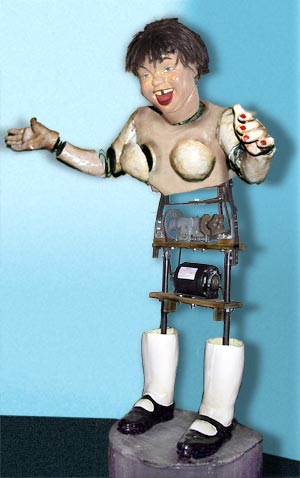 1945
advertisement from Philadelphia Toboggan Co. announcing
that post-war production of funhouse figures would
be resumed, although it is doubtful that this ever
occured.
1945
advertisement from Philadelphia Toboggan Co. announcing
that post-war production of funhouse figures would
be resumed, although it is doubtful that this ever
occured. |
|
An
examination of existing Laffing Sal figures rev-
eals paper strip layup in the torso regions which were
concealed by the clothing. But the head and hands are
much more smoothly detailed, leading to speculation
that their prod-
uction may be of another method, possibly a comp-
osition that OKC sometimes used called "Kingite", a
mixture of rosin, cornstarch and other fillers.In the
latter part of the Victor Dog prod-
uction period,
OKC
began making castings in rubber, specifically a latex
compound containing a clay filler which was poured into
plaster molds in a process similar to casting ceramics.
|
| The
major element that brought Sal to life was her unique
laughing movement.The mechanism which animated the department
store Santa figure was re-employed for Sal. There were
two basic movements: the torso moving incrementally
forward then pulling back upright, and the waving of
the arms. |
|
For
these actions two cams were used. The cams were mounted
on the single shaft of a Boston Gear 75:1 gear reduction
unit which was driven by a 1/4 hp electric motor concealed
in the hip region. A cam-pawl follower rode the underside
of each cam and linked to the upper-body torso for
the rocking motion. A longer connector extended to
a shaft in the shoulder area to which the arms were
fastened. These cams were cut in an undulating pattern
from 1/4 inch fiberboard, probably to avoid excessive
wear or flattening of the steel cam pawl rollers.
Rotating approximately once every eight seconds and
usually running during the entire time the park was
open, these cams wore down rapidly and needed frequent
replacement. When such maintenance was not observed,
the worn cams provided a more subdued level of animation.
At right, Laffing Sal showing mechanisms.
(William
Luca collection)
|
|
 |
Coil
springs also played a large role in Sal's movements. 2-inch
diameter springs held the hands to the forearms. Large 5-inch
diameter coils joined the arms at the elbows, and a similar
5-inch spring supported the head. Even her breasts were suspended
by springs to provide a jiggling effect as she laughed. Later
in production, three or four one-inch coil springs were substituted
for the larger head spring.
|







